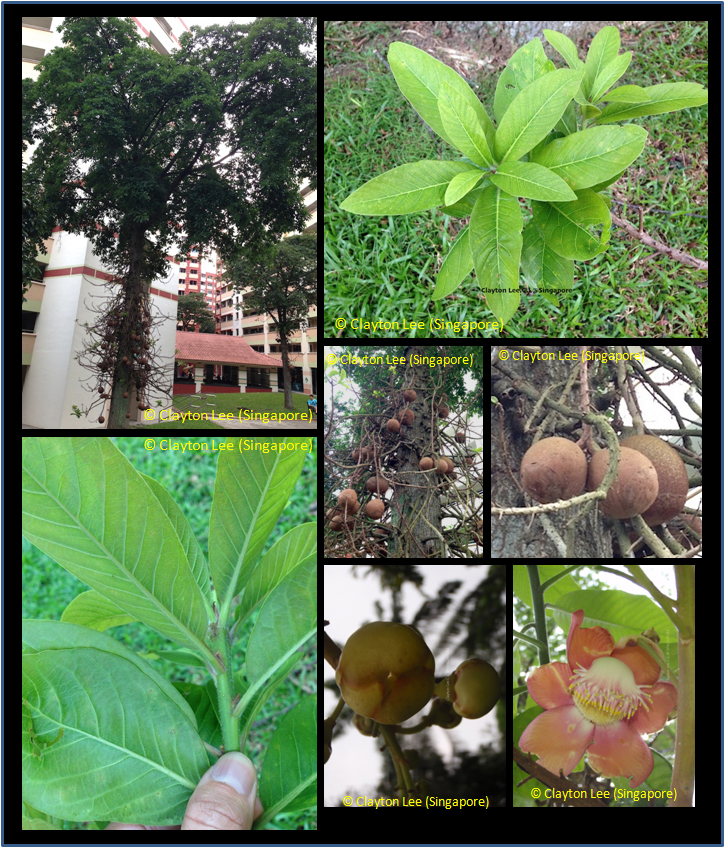Couroupita guianensis Aubl., Hist. Pl. Guiane 2: 708 1775
Species name meaning 'from the Guianas', an area on the north coast of South America.Synonyms
Couratari pedicellaris Rizzini
Couroupita acreensis R.Knuth
Couroupita antillana Miers
Couroupita froesii R.Knuth
Couroupita guianensis var. surinamensis (Mart. ex Berg) Eyma
Couroupita idolica Dwyer
Couroupita membranacea Miers
Couroupita peruviana O.Berg
Couroupita saintcroixiana R.Knuth
Couroupita surinamensis Mart. ex Berg
Couroupita surinamensis Mart. ex O. Berg
Couroupita venezuelensis R.Knuth
Lecythis bracteata Willd.
Pekea couroupita Juss. ex DC. [Invalid]
Diagnostics
Tree. Stipules absent. Large leaves placed alternate, slightly serrate margin. Flowers and fruits on the
trunk, sometimes completely covering the whole trunk. Flowers are yellow-pink and large, with conspicuous
stamens that form a ring and hood. Fruits are huge round capsules (25 cm diameter) resembling canon balls.
Inside many seeds can be found embedded within pulp.
Description
Tree up to 35 meters in height. The clustered leaves vary in length, generally from 8 to 31 centimeters,
but reaching up to 57 cm, they are oval, oblong, or broadly lance shaped; the leaf margins are smooth or
finely toothed. The flowers are borne on the tree stem in large bunches up to 90 cm long. Some trees
flower profusely, until the entire trunk is buried in flowers. One tree can bear 1000 flowers per day.
They are strongly scented, especially at night, and in the early morning. They are large, up to 6 cm wide,
and often brightly colored, the six petals in shades of pink and red near the bases and yellowish toward
the tips. There is a ring of stamens at the center, and an arrangement to stamens that have been modified
into a hood. The flowers produce two types of pollen, fertile pollen from the ring stamens and sterile
pollen from the hood structure. The large fruit, which is woody and very spherical, measuring up to 25 cm
wide, gives the species the common name "cannonball tree". A smaller fruit contains perhaps 65 seeds,
while a large one can have 550. One tree can bear 150 fruits. The fruit takes up to a year to mature in
most areas, sometimes as long as 18 months. [from Wikipedia]
Ecology
The flowers lack nectar, but are very attractive to bees coming for the pollen. The carpenter bee
Xylocopa brasilianorum is a common pollinator of cultivated trees in Rio de Janeiro, just outside
the tree's native range. Other carpenter bees such as Xylocopa frontalis, as well as wasps, flower
flies, and bumblebees visit the flowers. Bats are also important pollinators. The fruit falls from the
tree and often cracks open when it hits the ground. Sometimes they remain whole until an animal such as a
peccary breaks it open. Many animals feed on the fruit pulp and the seeds, such as the paca and domestic
chickens and pigs. The seeds are coated with trichomes which may help them pass through animal intestines.
Distribution
Originally from Central and South America, but currently cultivated pantropical.
Uses
This tree is planted as an ornamental for its showy, scented flowers, and as a botanical specimen for
its interesting fruit. The fruit is fed to livestock such as pigs and domestic fowl. The fruit is edible,
but not usually eaten by people because it can have an unpleasant smell. In India the tree is sacred to
Hindus, who believe its hooded flowers look like the naga, and it is grown at Shiva temples. There are
many medicinal uses for the plant. Native Amazonians use extracts of several parts of the tree to treat
hypertension, tumors, pain, and inflammation. It has been used to treat the common cold, stomachache,
skin conditions and wounds, malaria, and toothache. Laboratory tests show that extracts of the plant
have some antimicrobial activity and inhibit the formation of biofilms. The fruit pulp is rubbed on sick
dogs to cure them of mange.
Local names
Bengali: Nagkeshar.
Colombia: Coco sachapura.
Costa Rica: Bala de canon.
Dutch: Kanonskogel boom.
English: Cannonball tree.
French: Arbre ид boulet de canon.
French Guiana: Kouroupitoumou.
Indonesia: Sala.
Panama: Coco sachapura, Granadillo de las huacas.
Peru: Ayahuma.
Portuguese: Macacarecuia.
Suriname: Boskalebas.
